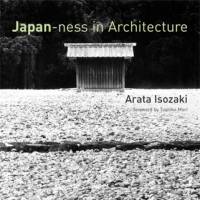In "Japan-ness in Architecture," architect and theorist Arata Isozaki chronicles the search for a Japanese identity through design. Isozaki begins by outlining Japan's architectural discourse in the 20th century, in which he played a key role. He writes honestly about his contemporaries who grappled with modernization, imperialism and war. He then looks backward to examine three historically significant buildings — Ise Shrine in Mie, Todaiji Temple's south gate in Nara and the Katsura Imperial Villa in Kyoto — drawing on extensive evidence to contextualize his analysis. All were "constructed amidst turmoil," which provided space for experimentation before aesthetic norms were "restabilized by a cultural Japanization."
Japan-ness in Architecture, by Arata Isozaki and David B. Stewart, Foreword by Toshiko Mori, Translated by Sabu Kohso.
376 pages
The mit press, Nonfiction.
He argues that the search for "Japan-ness" has always been prompted by foreign scrutiny. Contact with other cultures — from Tang Dynasty (618-907) China to postwar America — led to self-conscious attempts to construct a national identity. After all, he explains, an "insular nation" has no need to search for the "essence of its culture."
Isozaki believes that the search for "Japan-ness" ended around 1970, or at least changed unrecognizably in the postmodern era. "The external gaze that had long provoked Japan-ness was at last irrelevant," he boldly claims. "The time had come when we were able to view Japanese Japan-ness from a meaningful distance."
https://www.japantimes.co.jp/sports/2016/07/30/soccer/schweinsteiger-bows-out-of-duty-with-national-team/Read archived reviews of Japanese classics at jtimes.jp/essential.



















With your current subscription plan you can comment on stories. However, before writing your first comment, please create a display name in the Profile section of your subscriber account page.